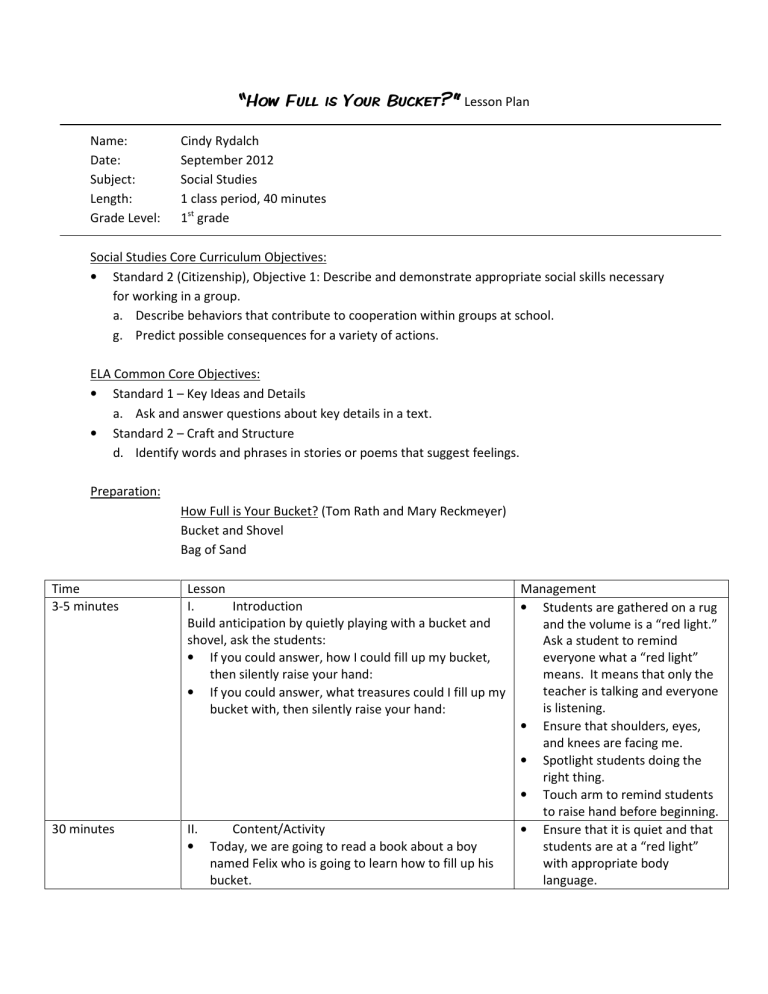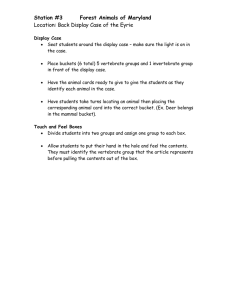
“How Full is Your Bucket?” Lesson Plan Name: Date: Subject: Length: Grade Level: Cindy Rydalch September 2012 Social Studies 1 class period, 40 minutes 1st grade Social Studies Core Curriculum Objectives: • Standard 2 (Citizenship), Objective 1: Describe and demonstrate appropriate social skills necessary for working in a group. a. Describe behaviors that contribute to cooperation within groups at school. g. Predict possible consequences for a variety of actions. ELA Common Core Objectives: • Standard 1 – Key Ideas and Details a. Ask and answer questions about key details in a text. • Standard 2 – Craft and Structure d. Identify words and phrases in stories or poems that suggest feelings. Preparation: How Full is Your Bucket? (Tom Rath and Mary Reckmeyer) Bucket and Shovel Bag of Sand Time 3-5 minutes Lesson I. Introduction Build anticipation by quietly playing with a bucket and shovel, ask the students: • If you could answer, how I could fill up my bucket, then silently raise your hand: • If you could answer, what treasures could I fill up my bucket with, then silently raise your hand: 30 minutes II. Content/Activity • Today, we are going to read a book about a boy named Felix who is going to learn how to fill up his bucket. Management • Students are gathered on a rug and the volume is a “red light.” Ask a student to remind everyone what a “red light” means. It means that only the teacher is talking and everyone is listening. • Ensure that shoulders, eyes, and knees are facing me. • Spotlight students doing the right thing. • Touch arm to remind students to raise hand before beginning. • Ensure that it is quiet and that students are at a “red light” with appropriate body language. We are going to take a picture walk through the • book, here is the main character, Felix. o Does this book look like a fiction or nonfiction book? o How do you know? • Based on our picture walk, what are you wondering or predicting might happen? o I want to know why there are buckets on top of everybody’s head. Give me a thumbs up if you were wondering about that too. Let’s find out. • Read the story through once to ensure that students understand the plot. o Raise your hand, if you remember a way that Felix empties his bucket? o Raise your hand, if you remember a way that Felix fills his bucket? • We are going to read the story again, this time I am going to fill Felix’s bucket when he chooses good actions, and we are going to empty the bucket when he chooses not so good actions. o o If I read something that shows Felix can fill his bucket, you are going to show me a thumbs up. o If I read something that shows Felix has to empty his bucket, you are going to show me a thumbs down. o Let’s practice, on the first page Felix’s little sister wants to play with him, and he says that she is too little. Are you going to show me a thumbs up or a thumbs down? o Ask someone why are you giving me a thumbs down….That’s right Felix is not making a good choice and he has to empty some of his bucket. o o Okay, are your thumbs ready? I will now they are ready when your hands are sitting quietly in your laps. Let’s begin. o III. Closure • a. Raise your hand if you have an idea of what Felix can do to make sure his bucket keeps nice and full? b. How did Felix empty his bucket? How did Felix fill up his bucket? c. How do you feel when you have a full bucket? • 5 minutes Use reinforcers like, “I like the way ________ raised his hand to answer.” Have everyone practice silently giving a thumbs up and thumbs down before continuing. Make sure hands are held quietly in lap while waiting for thumbs up or down. Do not begin until it is quiet. Focus on the positive and not the negative. IV. d. Now I want to fill up this whole bucket with o ideas that will help fill each other’s buckets. In order to fill it up, you will need to raise your hand and give me an idea of how to fill a classmate’s bucket. I will do the first, I can fill someone’s bucket by sitting by them at lunch. Okay, I can’t wait to see if we can fill this whole bucket with great ideas to make our classroom a great place. Make sure your hands are raised high, so I can call on everyone. Evaluation a. I will know students have learned through the closure activity. This will show me if students can really apply Felix’s situation to our own classroom. Remind students to be good listeners when they are waiting to be called on. Adaptations: I will make sure that my linguistically challenged and special needs students sit close to me. I will also make sure to bridge new vocabulary words with words they already know. Signals such as the thumbs up/down will help all students to participate and feel safe to do so. It will also ensure that all students are on-task and engaged. Integration: Students could use writing to fill up a bucket with wonderful positive actions that they can do at home to fill others’ buckets. We could also make a class bucket that would be displayed with positive ideas to make our classroom a safe and nice place to be. It would be simple to use a few math terms such as add and subtract when we are talking about filling or emptying the idea bucket. Just another way to reinforce new vocabulary, and use this vocabulary in a real-world setting.



